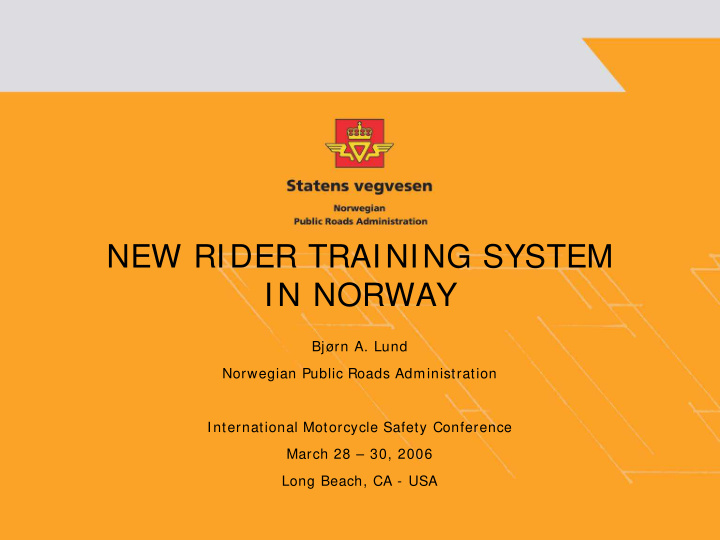



NEW RIDER TRAINING SYSTEM IN NORWAY Bjørn A. Lund Norwegian Public Roads Administration International Motorcycle Safety Conference March 28 – 30, 2006 Long Beach, CA - USA
Background • New rider and driver training system from 1. January 2005 • Aim: To establish a system which is based on recent research and theories on driver and rider training development • The new rider training system is ”tailor- made” for reduction of typical motorcycle accidents types
Theoretical foundation • The ”GADGET-project” (Hattaka et al. 1999) – Riding tasks arranged in levels • The GDE-matrix (Peräaho et al. 2003) – A model for developing and designing traffic education systems – Four hierarchic levels: • Highest level • Strategic level • Tactical level • Maneuvering level
Central content of rider education Risk Self-evaluation Knowledge increasing and skills factors Highest level Awareness of personal H Knowledge Knowledge Goals for lifte tendencies re. impulse about/control over about/control over I and skills for control, motives, lifestyle, how general life goals risks connected with E living (global) values etc. Developing and values, behavioral life goals and values, self-evaluation skills. R styoe, group norms etc. behavioral styles, affect riding social pressure, A substance abuse etc. R Knowledge and skills Strategic Knowledge and skills Awareness of personal C re. journey related level re. risks connected to planning skills, typical riding H consideretions Goals and journey goals, riding goals, riding motives, etc. I context of state, social pressure, Developing self-evaluation riding (spesific purpose of riding etc. skills C journey) A General knowledge Knowledge and skills L Tactical level Awareness of personal and skills re. rules, re. inappropriate speed, Mastery of skills, riding style, hazard speed adjustment, narrow safety margins, traffic situations perception, etc. from the L safety margins, disregard for rules, (spesific viewpoint of strenghts and signaling, etc difficult riding E situation) weaknesses. Developing conditions etc. self-evaluation skills V Maneuvering E Basic knowledge and Knowledge and skills Awareness of personal level skills re. vehicle re. risks connected with strenghts and weaknesses L (Spesific task) properties, friction etc. vehicle control, vehicle re. basic riding skills and properties, friction etc. vehicle control (especially in hazardous situations) etc. Developing self- evaluation skills.
Accident situation • Single vehicle accidents accounts for 44% of all motorcycle fatal accidents. (2000-2004) • Accident data indicates that a major part of these accidents occur during riding at ”normal” speed
Key points • Stepwise model • Focus on enhanced technical rider competence • Technical training must be balanced according to the GDE-matrix higher levels – Self-awareness – Self-insight • Mandatory safety course in precise riding technique • Mandatory safety course in safe road riding • Mandatory evaluation and guidance lessons
Stepwise model Driving Test (Practical Step 4 and Step 3 Traffic Theoretical) Mastery of Step 2 Safety Traffic Step 1 Situations Vehicle Manoeuvring Basic Knowledge Specific level of competence
Training system, category A1 and A Step 1 Step 2 Step 3 Step 4 Driving test Mandatory safety Practical Mandatory course in course in precise safe road riding riding technique A Course in Motorcycle- 8 mandatory lessons Theoretical basic road Driving. (both theoretical and traffic Interaction, practical) 4 mandatory lessons knowledge environment, safety (Mandatory) Mandatory course in Practical safe road riding 3 Theoretical 17 A1 lessons Theoretical lessons 4 mandatory lessons (Mandatory) Step 3: Mandatory safety course in precise riding A1 ⇒ A technique . Practical Step 4: As category A = Competence Objectives = Voluntary training – = Mandatory evaluation and guidance competency goals lesson = Mandatory training
Instructors competence • Instructors competence is paramount • A precondition for reaching the goals for the new training system • Established a two-years education for driving instructors at college level • Additional specialist training for motorcycle instructors • Special training for the examiners
Evaluation • Conducted by The Institute of Transport Economics, Oslo (TØI) • Commenced in 2004 (pre-group) • Ends in 2009 (after-group) • Evaluation parameters: – Involvement in traffic accidents – Technical skills and skills needed in traffic situations – Planning and preparing for a journey – Self–knowledge and self-assessment tendencies – Changes in rider population
Thank you bjorn.lund@vegvesen.no
Recommend
More recommend